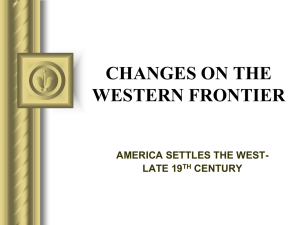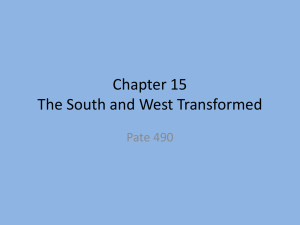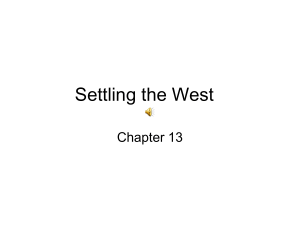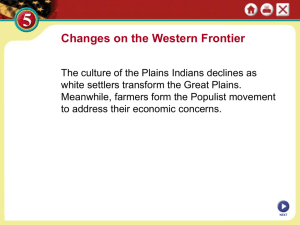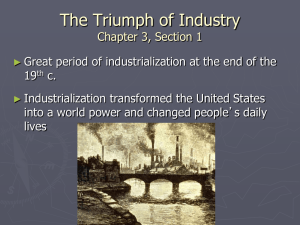Settling the Western Frontier
advertisement
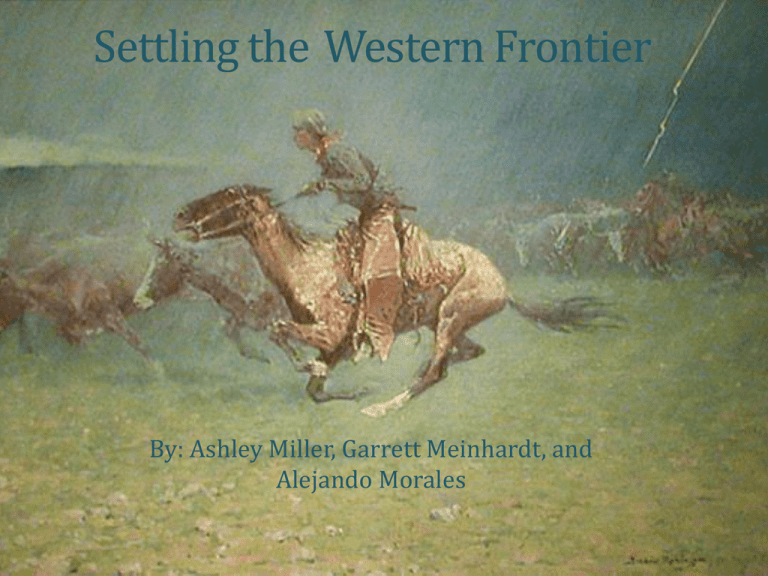
Settling the Western Frontier By: Ashley Miller, Garrett Meinhardt, and Alejando Morales Description • It took settlers 250 years to settle in the west. Settler’s believed they had a right to the land because the Native Americans who lived there had not settled down to “improve” the land. • Settlers’ were used to settling, mining, and creating new factories. However, the natives did not agree with the way the new settlers acted upon the land. • Clashes over beliefs and land occurred between natives and settlers. Especially since settlers tried to make Native Americans leave the land they had hunted on for over a hundred years. • The Treaty of Fort Laramie provided a temporary halt to warfare but the battles continued after both sides broke the treaty. According to the treaty the Sioux were to live on a reservation along the Missouri River. • The Dawes Act called for the break up of reservations and the introduction of Natives to American life. However, assimilation of the natives was a struggle and only led to more fighting. • When gold was found in South Dakota and Colorado the rush for land intensified. • Land itself also caused people to move to the West. In 1862, Congress passed the Homestead Act which offered 160 acres of land free to any citizen or intended citizen who was head of the household. • There were many common problems that farmers faced. The Grange was an organization for farmers that spent most of their time fighting railroads. Due to the Grange, Farmers’ Alliances were created. Alliances sent lecturers from town to town to educate people about topics such as lower interest rates on loans and governmental control over railroads and banks. Challenges • Natives and outlaws raided the settlers- Battle of Little Big Horn • Settlers tried educating the natives but the natives faced a dilemma between choosing their parent’s beliefs and their teacher’s beliefs. • If natives would try to fit in with the whites they would face discrimination. • Since trees were scarce, most settlers built their homes from the land itself. Many pioneers dug their homes into the sides of ravines or small hills. Those who moved to the broad, flat plains often made freestanding houses by stacking blocks of prairie turf. • Lightning was a constant danger, cowboys piled their metal objects at the edge of their camp to avoid attracting lightning bolts. • Between 1883 and 1887, alternating patterns of dry summers and harsh winters wiped out whole herds. Most ranchers then turned to smaller herds that would yield more meat per animal. Ranchers fenced their land with barbed wire. Problems • Clashes with Native Americans - The culture of the white settlers differed in many ways from that of the Native Americans on the plains. Natives and settlers clashed due to difference in beliefs and land. There were many tragic battles including the Massacre at Sand Creek. The Treaty of Fort Laramie provided only a temporary halt in warfare since both sides broke the agreement. The Indian Wars eventually stopped after the Battle of Wounded Knee where the Seventh Cavalry slaughtered as many as 300 mostly unarmed Native Americans, including several children. The soldiers then left the corpses to freeze on the ground. • Farming was Hard - Establishing a farm was hard. Once accomplished, it was constantly farming the prairie that became an overwhelming task. New inventions helped fix this problem, but these devices didn’t fully develop until the late 1800s with the migration of farmers onto the plains. • Expensive - Elaborate machinery was expensive, and farmers often had to borrow money to buy it. This situation gave rise to bonanza farms, enormous single-crop spreads of 15,000-50,000 acres. Some farmers mortgaged their land to buy more property, as farms grew bigger, so did farmers’ debts. Between 1885 and 1890, a lot of the plains experienced drought, and the large single-crop operations couldn’t compete with smaller farms, which could be more flexible in the crops they grew. The bonanza farms slowly became bankrupt. • Transportation - Railroads charged Western farmers a higher fee than they did farmers in the East to ship grain. Also, the railroads sometimes charged more for short trips than for long trips since there was no competing transportation. • Debt - Many farmers found themselves growing as much grain as they could grow, on as much land they could acquire, which caused them to go further into debt. • Lack of income - By the late 1800s prices of crops were falling and good crop land had become scarce. Benefits • Ranching - Ranching became a profitable investment. However, overgrazing, extended bad weather, and the invention of barbed wire ended the era of the wideopen West. Instead, the open plains turned into a series of fenced-in ranches. • Transportation - From 1850 to 1871, the federal government made huge land grants for railroads to lay down tracks in the West. The government granted 170 million acres, worth half a billion dollars. • Protection of Land - In 1872, the government created Yellowstone National Park to help protect the wilderness from settlement. • Inventions - New and improved farming equipment made farm work quicker and easier. The following are farming devices created: the steel plow that could slice through heavy soil (1837), reaping (harvesting) machine (1847), the spring-tooth harrow to prepare the soil (1869), the grain drill to plant the seed (1841), barbed wire to fence the land (1874), and the corn binder (1878). • Education - The federal government supported farmers by financing agricultural education. The Morrill Act of 1862 and 1890 gave federal land to the states to help finance agricultural colleges. The Hatch Act of 1887 established agricultural stations to teach farmers about new developments. Agricultural researchers developed ways to help the land retain moisture. These inventions allowed the dry eastern plains to flourish and become “the breadbasket of the nation.” To what extent can rapid development of a country be controlled? • Rapid development can be controlled to an extent, but is ultimately uncontrollable • The government can pass laws and make treaties such as the Treaty of Fort Laramie and the Dawes Act • Most are only temporary and result in only further problems • The government can provide transportation such as railroads, but they cannot control whether or not the public can afford it • Once transportation is widely used to expand, the factor of the land expansion are uncontrollable • Most factors such as weather, personal debt, and land quality are uncontrollable Multiple Choice Questions The treaty of Fort Laramie Created: a) an everlasting peace between the natives and settlers b) an agreement to join the native and American cultures c) a temporary peace between the natives and settlers d) an agreement to split the country in half for the Natives and Americans All were problems facing settlement except: a) b) c) d) Expensive transportation Inclement weather Native Americans Lack of Motivation to expand Multiple Choice Questions How did innovations effect farming? a) b) c) d) e) made it quicker made it slower but more effective made it easier had no affect A and C only
